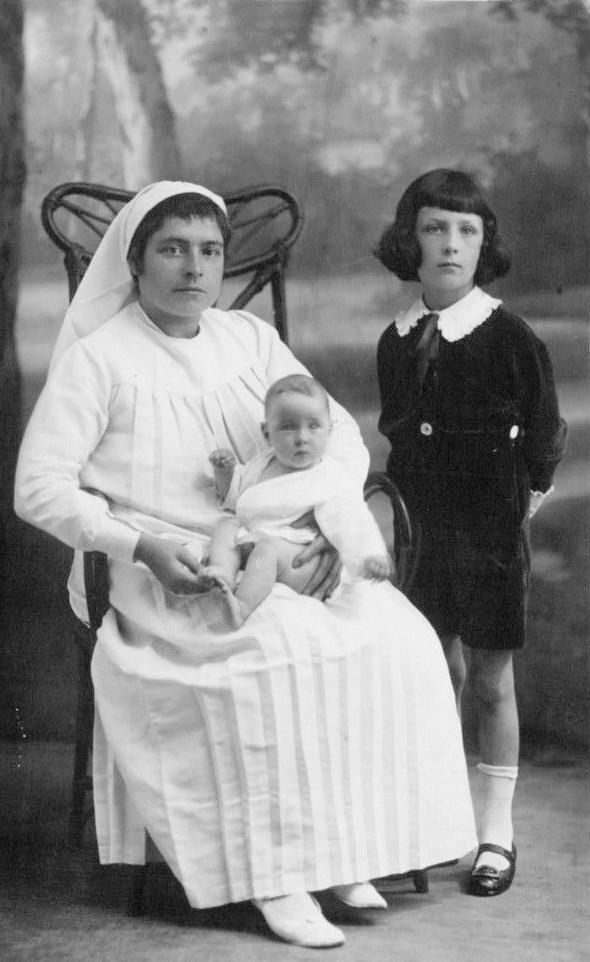
Final Fauntleroy Era: Decade Trends (1915-30s)

Figure 1.--This postcard back portrait shows a nanny taking care of two children, a babu and a boy about 6 years old. We do not know where it was taken. It is not America. We might guess Italy. It is also undated, but we would guess the early-1920s. The boy wears a modest scalloped coola and floppy bow, a shirt pants velvet suit, white three-quarter socks, and strap shoes.
|
|
World War I (1914-18) is a major dividing point in boys's fashions. The Fauntleroy suit which was still worn in the early 1910s, was much less common after the war and the early 1920s. I'm not sure precisely why this was. During the war, the rationing, the redirectiion of the economy to the war effort, and the need to focus on basic necesities probably made the extravegence and formality of the Fauntleroy style seem almost unpatriotic given the plain utilitarian approach to fashion. Another dynamic may have been operative after the War. The horrors of the war changed the outlook of many. Probably the fancy Fauntleroy styled seemed old fashioned and frivelous. And of course boys unless very young did not like it. Fauntleroy suits did not totaly disappear in the 1920s. Some boys still wore Fauntleroy suits or outfits with Fauntleroy touches, especially in the early-1920s. They were generally less elaborate suits. The ruffled collars worn in the 1910s began to disappear and were repaced with Peter Pan or other less frilly collars. Knee pants disappeared and were mostly replaced with short pants of various length. The Fauntleroy suit began to evolve in the 1920s into more modern suit styles, such as lapelless Eton suits for little boys. This process was largely completed in the 1930s although we continue to see some Fauntleroy stylistic touches.
The 1915-20
World War I (1914-18) is a major dividing point in boys's fashions. The Fauntleroy suit which was still worn in the early 1910s, was much less common after the war and the early 1920s. I'm not sure precisely why this was. During the war, the rationing, the redirectiion of the economy to the war effort, and the need to focus on basic necesities probably made the extravegence and formality of the Fauntleroy style seem almost unpatriotic given the plain utilitarian approach to fashion. Another dynamic may have been operative after the War. The horrors of the war changed the outlook of many. Probably the fancy Fauntleroy styled seemed old fashioned and frivelous. And of course boys unless very young did not like it.
>
Fauntleroy suits did not totaly disappear after World War I in the 1910s. We still see some examples in the 1920s. most of the examples we have found come from America, France, and Germany. We are not sjure if they were actually more common in these countries or this simplyh reflects the large numbers of photographic images abailable from those countries. We also see some examples from German influenced Central Europe. This is interesting because during the classic Fauntleroy era we did not see many German boys earing Funtleroy suits. Some boys still wore Fauntleroy suits or outfits with Fauntleroy touches, especially in the early-1920s. The Fauntleroy suits we see are more basic versions than we see eatlier. They were generally less elaborate suits. The ruffled collars worn in the 1910s began to disappear and were repaced with Peter Pan or other less frilly collars. Knee pants disappeared and were mostly replaced with short pants of various length, often worn with strap shoes. he Fauntleroy suit began to evolve in the 1920s into more modern suit styles, such as lapelless Eton suits for little boys.
The 1930s
The 1930s is the last decade that we see any number of boys earing Fauntleroy suits. Th Fauntleroy style was largely completed in the 1930s although we continue to see some Fauntleroy stylistic touches. We seen some Fauntleroy outfits after the 30s, but mostly special formal events like weddings. forml .
HBC

Navigate the Boys' Historical Clothing Strap Shoe-related Pages:
[White knee socks]
[School sandals]
[Pinafores]
[Smocks]
[Kilts]
[Ringlet curls]
[Fauntleroy suits]
[Buster Brown suits]
[Ring bearers]
Navigate the Boys' Historical Clothing Web Site:
[Return to The final Fauntleroy era page]
[Return to The long white stockings page]
[About Us]
[Introduction]
[Activities]
[Biographies]
[Chronology]
[Clothing styles]
[Countries]
[Theatricals]
[Topics]
[Bibliographies]
[Contributions]
[FAQs]
[Glossaries]
[Images]
[Links]
[Registration]
[Tools]
[Boys' Clothing Home]
Created: 5:08 AM 2/21/2017
Last updated: 5:08 AM 2/21/2017



